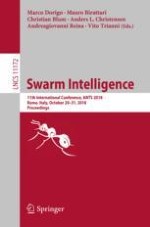2018 | OriginalPaper | Buchkapitel
The Best-of-n Problem with Dynamic Site Qualities: Achieving Adaptability with Stubborn Individuals
verfasst von : Judhi Prasetyo, Giulia De Masi, Pallavi Ranjan, Eliseo Ferrante
Erschienen in: Swarm Intelligence
Aktivieren Sie unsere intelligente Suche, um passende Fachinhalte oder Patente zu finden.
Wählen Sie Textabschnitte aus um mit Künstlicher Intelligenz passenden Patente zu finden. powered by
Markieren Sie Textabschnitte, um KI-gestützt weitere passende Inhalte zu finden. powered by
